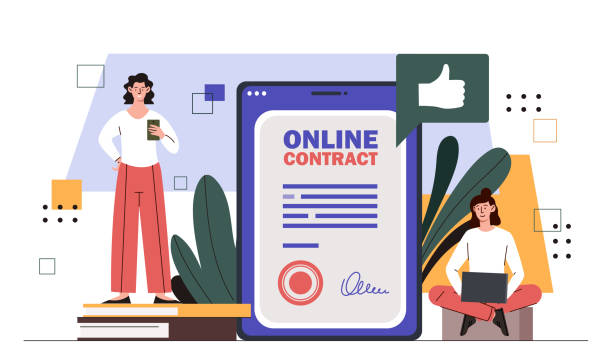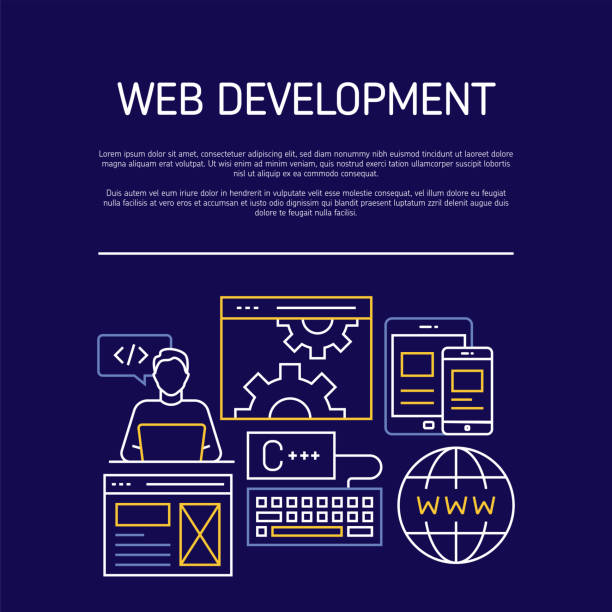Introduction and the Necessity of Responsive Web Design

In today’s world, where smart devices have become an indispensable part of our daily lives, accessing the internet via mobile phones, tablets, and laptops has become commonplace.
This diversity in screen dimensions highlights the need for a new approach in web development more than ever.
#Responsive Web Design# is a solution that ensures your website is displayed in the best possible way on any device, from the smallest smartphone to the largest desktop monitor, providing an optimal user experience.
This approach is not just a luxury feature but an undeniable necessity for every business and individual operating in the online space.
Its absence can mean losing a large portion of your audience and weakening your digital presence.
This educational and explanatory section helps you gain a deeper understanding of the importance of this concept.
Responsive design not only leads to an improved user experience but also plays a vital role in SEO (Search Engine Optimization) and website ranking in search engines.
Google and other search engines prioritize websites that are optimized for mobile, meaning without responsive design, you will likely fall behind your competitors.
In fact, this approach signifies the flexibility and adaptability of the website to any environment the user might use.
The main goal is to present content in an organized and accessible manner, without the user needing to zoom or horizontal scroll.
This is the initial step to enter the modern web world and maintain effective communication with your users.
Is your company’s website as professional and trustworthy as it should be? With specialized corporate website design by Rasawob, create an online presence that reflects your credibility and attracts more customers.
✅ Build a powerful and professional image for your brand
✅ Convert visitors into real customers
⚡ Get free consultation now!
Basic Principles and Key Concepts of Responsive Design

A deep understanding of the fundamental principles is crucial for the successful implementation of a responsive website.
These principles include three main pillars: #Media Queries#, #Fluid Grids#, and #Flexible Images#.
Media Queries in CSS are the beating heart of responsive web design.
They allow developers to apply different styles based on device characteristics such as screen width, height, type (screen, print), and orientation using conditional statements.
For example, you can define that on smaller screens, content columns appear one below the other instead of side by side.
Fluid grids use relative units like percentages instead of fixed pixel units to define element widths.
This means that element sizes dynamically change with screen size, and content adjusts seamlessly.
Flexible images, by using properties like `max-width: 100%;` in CSS, ensure that images never overflow their container and scale appropriately to the available space.
This technical and educational section helps you become familiar with these technical concepts.
Without mastering these foundations, creating a seamless user experience across different devices is almost impossible.
Furthermore, concepts like Mobile-First have gained significant importance; in this approach, design begins with mobile devices and their limitations, then gradually expands to larger screens.
This method ensures that the core user experience is optimized from the start for limited environments, and then additional functionalities are added for more powerful devices.
Understanding these concepts is the first step towards creating websites that are truly effective in the current era and meet user needs.
Common Tools and Techniques in Responsive Design

To effectively implement responsive web design, developers require a set of efficient tools and techniques.
In this section, we will discuss some of the most commonly used ones that are highly popular in the web community.
#Frameworks# like Bootstrap and Foundation are powerful tools that provide a set of pre-built responsive styles and components.
These frameworks significantly accelerate the design and development process, allowing designers to create responsive websites without needing to write CSS code from scratch.
In addition to frameworks, new CSS techniques like Flexbox and CSS Grid have revolutionized responsive layouts.
Flexbox is ideal for one-dimensional layouts (rows or columns), while CSS Grid gives developers unparalleled power in creating two-dimensional and complex layouts.
These tools provide high precision and flexibility in managing space between elements, their order, and making the layout responsive.
This technical and guidance section paves the way for you to choose the best tools.
Also, for image optimization, techniques such as using the `srcset` and `sizes` attributes in the `` tag can be employed, which allow the browser to select and load the best image size based on the user’s device.
Modern web development tools like Preprocessors (e.g., Sass and Less) also make writing CSS code more organized and maintainable by adding features such as variables, functions, and nested rules.
Below, a table of common tools is provided to aid better understanding:
| Tool/Technique | Description | Main Application |
|---|---|---|
| Media Queries (Media Queries) | CSS rules for applying styles based on device characteristics (width, height, type). | Core of CSS responsiveness. |
| Flexbox (Flexbox) | A CSS layout module for distributing space between items in a container. | Creating one-dimensional layouts (rows or columns). |
| CSS Grid (CSS Grid) | A two-dimensional layout module for designing more complex pages. | Designing full-page layouts (two-dimensional). |
| Bootstrap (Bootstrap) | Most popular CSS framework for developing responsive websites. | Rapid and easy development of responsive user interfaces. |
User Experience and the Impact of Responsive Design on It

One of the most important aspects of responsive web design is its direct and profound impact on User Experience (UX).
In today’s world, where users access online content from a variety of devices, providing a seamless and enjoyable experience across all platforms is crucial.
#User experience# means how your website interacts with its users and what feeling it creates in them.
Websites that are not properly responsively designed often lead to issues such as horizontal scrolling, excessive text and image shrinking, and difficulty clicking on links on mobile devices.
These issues not only frustrate users but also increase the bounce rate and ultimately lead to the loss of customers or visitors.
Responsive design, by automatically adapting layout and content to screen size, ensures that users do not need to zoom, drag the page, or navigate with difficulty.
This analytical and explanatory section shows you how responsiveness improves interactivity.
A responsive website also helps improve the #User Interface# (UI), as elements are arranged to be visible and clickable at any size.
Furthermore, it increases user time on site, as a smooth and hassle-free navigation experience encourages users to explore more content.
Increased user engagement and satisfaction not only lead to their loyalty but can also help improve SEO and website ranking.
Ultimately, responsive web design is an investment in user satisfaction, whose positive results will become apparent in the long run.
Does your current corporate website not reflect your brand’s credibility and power as it should? Rasawob solves this challenge for you with professional corporate website design.
✅ Increase credibility and visitor trust
✅ Attract more targeted customers
⚡ Click to get free consultation!
Optimizing Speed and Performance in Responsive Websites

Website loading speed is one of the critical factors in its success, especially in the mobile era.
Today’s users have high expectations for speed, and research shows that even a few milliseconds of delay can lead to lost visitors.
In the context of responsive web design, performance optimization becomes doubly important, as it must be ensured that the website loads with the same speed and efficiency across different devices.
One of the biggest challenges is image management.
High-quality images optimized for desktop displays can become a major slowing factor on mobile devices with slow internet.
To solve this problem, techniques such as #Image Optimization# using modern formats (WebP), proper compression, and adaptive images (Responsive Images) that load based on screen size are very effective.
This technical and guidance section explains methods for increasing speed.
Also, using Lazy Loading for images and videos, which only load when the user scrolls to them, can significantly increase the initial page loading speed.
Optimizing CSS and JavaScript code is another important measure; minification of files and concatenating them help reduce the number of HTTP requests and improve loading speed.
Browser caching and CDN (Content Delivery Network) are also crucial for storing content on the server closest to the user and reducing server response time.
For responsive websites, these measures not only improve user experience but also impact SEO ranking, as search engines prefer faster websites.
Focusing on these technical aspects guarantees the success of your website in providing an efficient and fast experience to users on any device.
Challenges and Solutions for Responsive Web Design

Despite numerous advantages, implementing responsive web design is not without challenges.
One of the main difficulties is #code complexity#.
Writing code that functions correctly across all devices and browsers requires great precision and planning.
Managing breakpoints and ensuring that content looks optimal on every screen size can be time-consuming.
The solution to this challenge is to use a Mobile-First approach, starting the design from the smallest screen and then gradually developing it for larger screens.
This method helps simplify code and reduce complexity.
Another challenge is #testability#.
Given the countless variety of devices and screen sizes, testing a responsive website in all possible scenarios is difficult.
To overcome this, using emulator tools, testing in various browsers, and even physical testing on real devices are recommended.
This thought-provoking and analytical section addresses more complex aspects.
Content management is also a significant challenge; some types of content, such as complex tables or interactive charts, may not adapt well to responsive layouts and require specific solutions like smart horizontal scrolling or conversion to simpler graphics for mobile.
Maintaining performance alongside flexibility is itself a challenge; optimizing images, minifying files, and using lazy loading techniques are essential to ensure high loading speed on different devices.
Browser and operating system inconsistencies can also be problematic, which is why using web standards and thorough testing is of high importance.
With proper planning and the right tools, these challenges can be overcome, and a truly responsive and efficient website can be built.
The Future of Web Design and the Indispensable Role of Responsiveness

The future of web design is inextricably linked with the concept of responsive web design.
With the emergence of new technologies and increased use of smart devices, the need for websites that perform optimally on every platform is felt more than ever.
Emerging trends like #Progressive Web Apps# (PWAs) and Accelerated Mobile Pages (AMP) are built upon the principles of responsiveness.
PWAs strive to provide a user experience similar to native applications through the web, with features like offline functionality, push notifications, and access to device hardware.
AMP also focuses on mobile page loading speed and provides an extremely fast user experience by using lighter versions of HTML and CSS.
This news and analytical section shows you new horizons.
Artificial Intelligence and Machine Learning will also play an increasing role in optimizing user experience, from content personalization to automatic layout optimization based on user behavior.
These technologies can make the responsive web design process smarter and more dynamic.
Virtual Reality (VR) and Augmented Reality (AR) also provide new opportunities for interacting with web content, and future websites must be able to adapt to these immersive experiences.
Finally, the concept of Content-First Design is also gaining prominence; this approach focuses on ensuring that content is accessible and consumable regardless of the device, and the layout should be shaped around it.
These new trends show that responsiveness is not just a technique, but a design philosophy that prepares websites for a future with diverse platforms and advanced interactions.
| Trend | Description | Importance in the Future |
|---|---|---|
| Progressive Web Apps (PWA) | Websites that offer a native app user experience. | Improved offline experience and increased user engagement. |
| Accelerated Mobile Pages (AMP) | A framework for building fast web pages for mobile. | Increased page loading speed in mobile search results. |
| Content-First Design | Focus on content before layout and visual appearance. | Ensuring accessibility and readability on any device. |
| Dark Mode | User interface display options with a dark background. | Reduced eye strain and battery saving. |
The Impact of Responsive Web Design on SEO and Google Ranking

In the competitive world of SEO, Responsive Web Design is no longer an optional choice but a vital factor for success in search engines.
Google has officially stated that it prefers websites with responsive design, and this is reflected in its ranking algorithms.
#SEO# is not limited to keywords and backlinks; user experience and mobile compatibility are also highly important.
Websites that are not optimized for mobile face an increased Bounce Rate, as users quickly leave them, sending a negative signal to search engines.
On the other hand, a responsive website, by providing a seamless user experience across all devices, increases user time on site and reduces the bounce rate, which in turn helps improve Google ranking.
This technical and explanatory section examines the role of responsiveness in your site’s visibility.
Also, by using a single URL for all devices, the crawling and indexing process becomes simpler for Google, as there is no need to manage separate mobile and desktop versions.
This prevents the creation of Duplicate Content and centralizes SEO power.
Page loading speed, which is a side benefit of responsive design, is also an important factor in Google’s ranking.
Google prefers faster websites because they provide a better user experience.
Finally, given Google’s Mobile-First Indexing algorithm, where the mobile version of your website is the primary basis for ranking, the importance of responsive web design has become more critical than ever.
Ignoring this aspect means missing out on great opportunities for visibility in search results.
Are you concerned about your e-commerce site’s low conversion rate and not achieving your desired sales?
Rasawob is your specialized solution for having a successful e-commerce site.
✅ Significant increase in conversion rate and sales
✅ Professional and user-friendly design to gain customer satisfaction
⚡ Ready for an online sales transformation? Get a free consultation!
Practical Steps for Implementing a Responsive Website

Implementing a responsive website requires a systematic and step-by-step approach to ensure a high-quality final result.
This process usually begins with precise phasing.
The first step is planning and research.
In this stage, the target audience, their used devices, and the site’s content must be carefully examined.
#Responsive design# requires a deep understanding of user experience across different dimensions.
The second step is visual design.
It is best to start with a Mobile-First approach; first, design the layout and visual elements for the smallest screen, and then gradually expand it for larger devices.
This ensures that the core content and functionality are displayed well across all platforms.
This guidance and educational section will be useful for you.
The third step is development and coding.
In this stage, HTML5 is used for content structuring, CSS3 (especially Media Queries, Flexbox, and CSS Grid) for responsive layout and styling, and JavaScript for adding dynamic interactions.
Using CSS frameworks like Bootstrap can also significantly accelerate the development process.
The fourth and very crucial step is #cross-browser and device testing#.
The website must be tested across different browsers (Chrome, Firefox, Safari, Edge) and on various devices (mobile, tablet, desktop) with different screen sizes to ensure its correct functionality.
Ultimately, responsive web design is an iterative process, and with user feedback and data analysis, it can be improved and prepared for the future.
Adhering to these steps ensures that your website will not only be beautiful but also fully functional and optimized in any environment.
Summary and Conclusion on the Importance of Responsive Design

At the end of this comprehensive review, it can be confidently stated that Responsive Web Design is not just a passing trend but the backbone of the #future of the web# and the cornerstone of any successful online presence.
Given the increasing number of internet users via mobile devices and tablets, ignoring this approach means losing a significant portion of the audience and falling behind competitors.
This explanatory and engaging section summarizes the importance of this topic.
The benefits of responsive design go beyond aesthetics; this approach helps improve user experience, increase conversion rates, reduce bounce rates, and significantly enhance website SEO.
Responsive websites are preferred by search engines like Google, leading to increased accessibility and visibility in search results.
Its fundamental principles, namely media queries, fluid grids, and flexible images, along with powerful tools like frameworks and new CSS techniques, enable developers to build websites that perform optimally on any platform.
Although challenges such as code complexity and the need for extensive testing exist, these can be overcome with a Mobile-First approach and by employing best practices.
Ultimately, investing in responsive web design is an investment in the future of your business and guarantees its sustainability and growth in the digital space.
This is an essential innovation that should be at the forefront of every web strategy.
Frequently Asked Questions
| Question | Answer |
|---|---|
| What is Responsive Web Design? | It is a method for designing and implementing websites that ensures the layout and content automatically adjust and display optimally based on the user’s device screen size (desktop, tablet, mobile, etc.). |
| Why is responsive design important? | With increasing use of various devices to access the web, a responsive site improves user experience, reduces bounce rate, strengthens site SEO, and simplifies site management and maintenance (instead of having separate versions for mobile and desktop). |
| How does responsive design work? | This type of design uses techniques such as flexible grids and layouts (Flexbox, CSS Grid), flexible images and media, and most importantly, CSS Media Queries to change page styles and layouts based on screen characteristics (width, height, resolution, etc.). |
| What are the main tools for implementing responsive design? | The main tools include HTML5 (for content structure), CSS3 (especially Media Queries, Flexbox, Grid for responsive styling and layout), and sometimes JavaScript for more complex interactions. |
| What are the main benefits of using responsive design? | The main benefits include increased user accessibility (covering a wide range of devices), improved user experience, better site ranking in search engines (especially Google), reduced development and maintenance costs, and increased conversion rates from visitors to customers. |
And other services of Rasawob Advertising Agency in the field of advertising
Targeted advertising on Instagram for medical product sellers
How to use LinkedIn for B2B marketing of medical products
Creating blog content to attract customers for medical products
Utilizing local SEO for advertising medical equipment vendors
The role of email marketing in selling medical products
And hundreds of other services in the field of internet advertising, advertising consultation, and organizational solutions
Internet Advertising | Advertising Strategy | Advertorial
🚀 Transform your business’s digital presence with Rasawob’s internet advertising strategies and advertorials.
📍 Tehran, Mirdamad Street, Next to Central Bank, Southern Kazeroun Alley, Ramin Alley, No. 6

